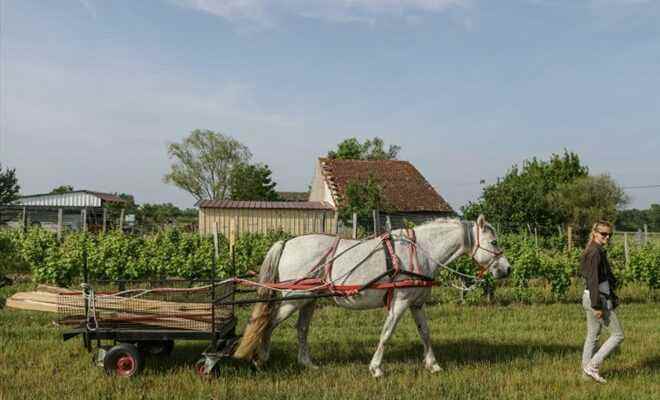Franck Favereaux (D) trained on May 20, 2022 at the Winegrower Horse School in Saint-Savin, in Gironde, Audrey Pic (C) and Raphaëlle Verdaime-Siorat (G) (AFP / Thibaud MORITZ)
“Hector, yo hooo!”: In the vineyards of northern Gironde, Audrey Pic firmly directs a draft horse hitched to a harrow. At the Ecole du Cheval Vigneron, she trained in a practice that is making a comeback in the vineyards for ecological reasons.
“The power of the animal is crazy,” enthuses this young woman from the Bouches-du-Rhône, who is learning to master the U-turn at the end of a row with her “schoolmaster”, the horse Hector, a Breton, under the watchful eye of a trainer.
“Keep the outer guide tight,” advises the latter, Franck Favereaux, green jacket and leather hat. “It wasn’t very academic!” he said after the maneuver.
In addition to the technical aspect, he teaches the trainee to “form a pair” with his horse for “optimal safety”.

Audrey Pic in training on May 20, 2022 at the Winegrower Horse School in Saint-Savin, Gironde (AFP / Thibaud MORITZ)
Eventually, Audrey wishes to acquire a horse and “help friends who have hectares of vines in Vaucluse”.
The school was created by the French Society of Working Equidae (SFET) because “more and more estates are reintroducing the horse into their vines”, explains Sophie Parel, training officer.
The establishment has trained around forty people since 2020, in initiation at Saint-Savin, like Audrey, or in advanced training at Château Soutard (Saint-Emilion).
The horse responds to “an increasing demand from winegrowers to find ways to maintain their soil by trying to preserve its quality and life, with fewer herbicides and less compaction”, explains Clémence Bénézet to AFP. , engineer at the French Institute for Horses and Riding (IFCE).
According to her, at least 300 wine growers use horse traction on part of their estate, a non-exhaustive figure. The vast majority do not own a horse and use service providers.

Franck Favereaux trains Audrey Pic on May 20, 2022 at the Winegrower Horse School in Saint-Savin, Gironde (AFP / Thibaud MORITZ)
The horse works more slowly than the tractor but allows “more precise work”, slips Ms. Bénézet. “We can train the horse so that it stops at the slightest resistance and does not tear up the vines and therefore make it work in twisted old vines or very fragile young plants”.
– “Touch language” –
At the Château de Rouillac (Pessac-Léognan), where reigns Titan, a massive white Percheron, the horse “is not a stylistic effect”, assures the boss Laurent Cisneros.
It is “our partner in achieving sustainable control of our terroir”, he explains. “It is also a pleasure for the eyes and ears of local residents. Everything is done in silence and serenity.”
And in terms of the carbon footprint, “we did our calculations: with almost 60% of the area worked by workhorses, we reduced our emissions by 15%”.

Jessica Aubert, winemaker and owner of Château Nodot, leads Diamant, a purebred Spaniard, to her vineyards on May 19, 2022 in Saint-Christoly-de-Blaye (AFP/Thibaud MORITZ)
At Château Nodot (Blaye – Côtes de Bordeaux), Jessica Aubert, 39, reintroduced the horse in addition to the tractor, “in an environmental and ecological approach” and because she wanted to “combine passion and work”.
This Girondine who worked in finance before taking over the family property, now biodynamic, however regrets the “quite prohibitive” cost of equine traction tools. “Some are at least as expensive, or even more, than what you put behind a tractor…”. As a result, his tools “are not ergonomic enough”.
With her two accomplices, Hugo the Percheron, and Diamant the purebred Spanish, used for cleaning the floors and maintenance work and whom she rewards with alfalfa croquettes, Ms. Aubert has developed a “strong bond”.

Jessica Aubert, winemaker and owner of Château Nodot, and her horse Diamant, a purebred Spanish, on May 19, 2022 in Saint-Christoly-de-Blaye (AFP / Thibaud MORITZ)
In addition to the voice, she communicates with them through gestures or “a tactile language”, as when she stops the burly Hugo with a simple touch on the shoulder. “There are no constraints, I don’t pull on the lanyard, they don’t have bits”.
“The horse also has to have a good time”, she says again, “we know we have won when the horse returns to the meadow more slowly than it came out of it”.
© 2022 AFP
Did you like this article ? Share it with your friends with the buttons below.




